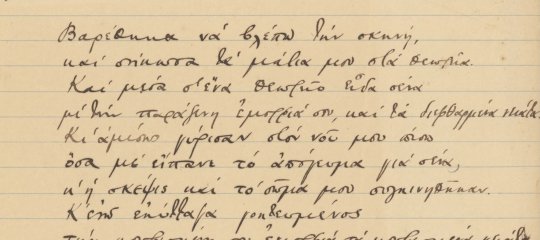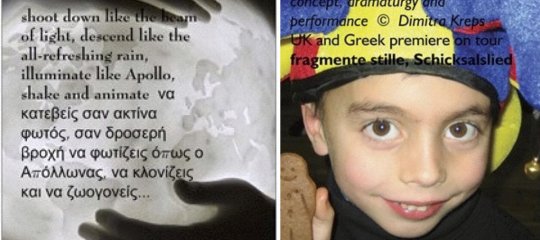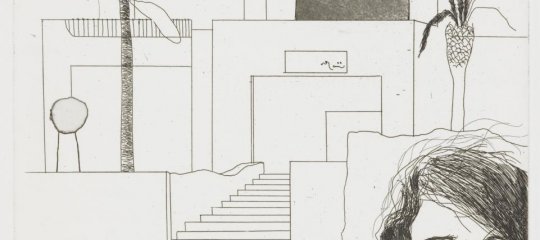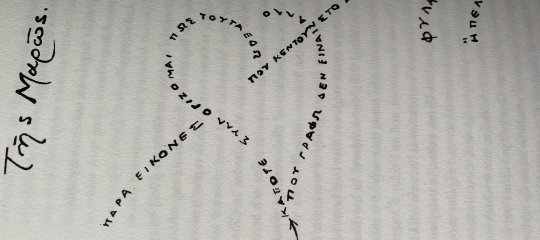Αξάνα Τσιόχα: Τα αρχαία ελληνικά στο Λομονόσοφ
MihalisPatsis writes, "Η έρευνα έγινε από την φοιτήτρια του 5ου έτους του τμήματος Βυζαντινής και Νεοελληνικής Φιλολογίας Αξάνα Τσιόχα. Έφτιαξε και μοίρασε ερωτηματολόγιο, το έδωσε στους φοιτητές των άλλων τμημάτων και μετά το επεξεργάστηκε και μου έδωσε το κείμενο.
Μ.Πάτσης
"
21 Ιουνίου 2004
Αξάνα Τσιόχα
Η αρχαία ελληνική στο ρωσικό και σλαβικό τμήμα: έρευνα.
Ο σκοπός αυτής της έρευνας ήταν να εκδηλωθεί η γενική εντύπωση που αφέθηκε από τα μαθήματα της αρχαίας ελληνικής στο μυαλό μας , δηλαδή στο μυαλό των φοιτητών για τους οποίους τα ελληνικά δεν είναι μητρική γλώσσα. Εμείς που σπουδάζουμε στην φιλολογική σχολή πρέπει να παρακολουθούμε μερικά μαθήματα για την Γενική και Συγκριτική Γλωσσολογία, στα πλαίσια των οποίων μας προσφέρονται τα λατινικά και τα αρχαία ελληνικά, στο πρώτο και στο δεύτερο έτος αντίστοιχα.
Ως προς τις στατιστικές μονάδες, ρωτήθηκαν είκοσι φοιτητές και φοιτήτριες από τα τμήματα ρωσικής και σλαβικής φιλολογίας, το δείγμα ήταν τυχαίο. Τώρα αυτοί είναι στο τρίτο, τέταρτο και πέμπτο έτος. Όλοι έδωσαν τις απαντήσεις τους στα παρακάτω ερωτήματα.
1. Πόσο συχνά παρακολουθούσατε τα μαθήματα της αρχαίας ελληνικής γλώσσας; (Αν έχετε κάνει απουσίες δώστε την αιτία τους).
2. Πώς σας φάνηκαν τα μαθήματα της αρχαίας ελληνικής γλώσσας;
3. Ποια πράγματα σ' αυτά έμειναν στη μνήμη σας;
4. Γράψτε σας παρακαλώ τον αριθμό των κλίσεων της αρχαίας ελληνικής, σύμφωνα με το εγχειρίδιο της κ. Σλαβιατίνσκαγια.
5. Γράψτε την πρώτη λέξη από την αρχαία ελληνική γλώσσα που θυμάστε.
Τα αποτελέσματα της έρευνας έδειξαν:
1.Ως προς την παρακολούθηση των μαθημάτων:
50% έχουν απουσιάσει έξι ή επτά μαθήματα
20% έχουν απουσιάσει στα μισά μαθήματα
15% έχουν απουσιάσει περισσότερο από τα μισά μαθήματα
15% έχουν απουσιάσει λιγότερο από τα μισά μαθήματα.
Όλοι έχουν κάνει απουσίες στα μαθήματα, αν και μερικοί ισχυρίζονται πως προσπαθούσαν να μην απουσιάσουν.
Οι λόγοι:
Ασθένεια
Η ώρα του μαθήματος ήταν πολύ νωρίς
Έλλειψη διάθεσης και προσωπικά σχέδια
Εργασία στη βιβλιοθήκη
2.Ως προς τα μαθήματα:
Στο 70% τους άρεσαν τα μαθήματα
Στο 10% δεν τους άρεσαν τα μαθήματα
Στο 20% τους άρεσαν πότε-πότε.
3.Στη φοιτητική μνήμη έμειναν
ο καθηγητής 20%
οι εξετάσεις 15%
οι ομιλίες του Δημοσθένη 5%
τα ανώμαλα ρήματα και Accusativus cum Infinitivo (ετεροπροσωπία) (15%)
τα ποιήματα της Σαπφούς και του Ανακρέοντα 15%
τα ευαγγελικά κείμενα 15%
κάποια επιτάφια 5%
η πλήξη και οι ελληνικές λέξεις στον πίνακα 5%.
4.Οι κλίσεις της αρχαίας ελληνικής σύμφωνα με το εγχειρίδιο της κ. Σλαβιατίνσκαγια είναι τρεις.
Όμως:
Μόνο το 25% των φοιτητών θυμούνται τον ακριβή αριθμό.
35% δεν θυμούνται καθόλου
25% θεωρούν πως υπάρχουν πέντε κλίσεις
10% θεωρούν πως υπάρχουν τέσσερις κλίσεις
5% θεωρούν πως υπάρχουν δύο κλίσεις.
5.Οι λέξεις που έμειναν στο μυαλό μας είναι:
ο άνθρωπος 15%
ο νόμος 10%
ο λόγος 10%
κακός, καλός 10%
ο οίκος 5%
ο βίος 5%
η αγορά 5%
το βιβλίον 5%
ο κύων 5%
η φιλολογία 5%
η παρθένος 5%
ο Παρθενών 5%
Επίσης εμφανίστηκαν ως διπλές απαντήσεις, οι λέξεις
Η ελληνική γλώττα
Φιλώ
Γράφω
Πολλών ω άνδες Αθηναίοι, λόγων γιγνομένων
Καθαίρω
Πιπράσκω
- Εισέλθετε στο σύστημα για να υποβάλετε σχόλια










